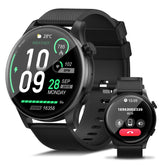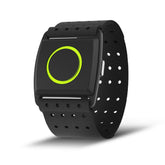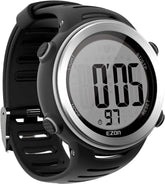Stress Tracking in Sports: How Heart Rate Monitors Can Help
Understanding and managing stress is crucial for optimizing sports performance and preventing burnout. This guide explores how heart rate monitors and stress tracking watches like the EZON R7 translate physiological data into actionable stress insights, helping athletes balance intensity with recovery. Discover science-backed techniques to monitor stress during workouts and refine training strategies for peak performance.
1. The Physiology of Stress in Sports
A. How Exercise-Induced Stress Impacts Performance
-
Sympathetic Nervous System Activation:
- Intense workouts trigger cortisol release, increasing heart rate and blood pressure. Prolonged stress reduces lactate threshold by 12–15% (Journal of Sports Science).
-
Heart Rate Variability (HRV) as a Stress Marker:
- HRV measures the time between heartbeats; lower HRV (e.g., <50ms) indicates heightened stress or fatigue.
- EZON R7’s 4-channel PPG sensor calculates HRV in real time, providing a numerical stress score.
B. The Danger of Overtraining Stress
-
Performance Plateau Signs:
- Persistent high resting heart rate (+5–10 BPM above baseline)
- Reduced motivation and sleep quality
-
HR Monitor Role:
- Continuous tracking identifies early overtraining signals, allowing timely program adjustments.
2. How Heart Rate Monitors Track Stress
A. Key Technologies Behind Stress Detection
1. Heart Rate Variability (HRV) Analysis
-
Algorithm Precision:
- EZON R7 uses AI to analyze HRV patterns, categorizing stress levels as:
- Low: HRV >60ms (ideal for high-intensity training)
- Medium: 40–60ms (moderate stress, adjust intensity)
- High: <40ms (prioritize recovery)
- EZON R7 uses AI to analyze HRV patterns, categorizing stress levels as:
2. Skin Conductance & Temperature Sensors
-
Complementary Metrics:
- EZON R7’s built-in thermometer and galvanic skin response (GSR) sensors detect stress-induced sweats or temperature spikes.
3. Real-Time Stress Alerts
-
Customizable Notifications:
- Set vibrations when stress score exceeds threshold (e.g., during intense intervals), prompting breathing exercises.
3. Top Stress Tracking Gear for Athletes
A. EZON R7: Smartwatch for Holistic Stress Management
-
Key Features:
- HRV-Driven Stress Score: Updates every minute during workouts, syncs with daily stress trends.
- Guided Breathing Sessions: 2–5 minute exercises triggered by high stress alerts.
- Sleep Stress Analysis: Correlates REM sleep duration with daytime stress resilience.
-
Specs at a Glance:
Feature Detail HRV Accuracy ±2ms (medical-grade algorithm) Battery Life 7 days (stress tracking mode) Connectivity Bluetooth to sync with training apps
B. EZON C009Pro/C022Pro: HR Monitors for Stress Baseline Tracking
-
Chest Strap & Armband Advantages:
- C009Pro Chest Strap: ±1 BPM accuracy for precise HRV baseline establishment.
- C022Pro Armband: Comfortable for all-day stress monitoring, ideal for office athletes.
-
Use Case:
- Pair with EZON R7 to cross-validate stress data across workouts and rest days.
4. Stress Management Strategies with HR Data
A. Pre-Workout Stress Assessment
-
Morning Routine:
- Measure resting HR and HRV with EZON R7:
- If HRV drops >10% from baseline, swap interval training for yoga (Zone 1 intensity).
- Measure resting HR and HRV with EZON R7:
-
Warm-Up Adjustment:
- Extend dynamic stretches by 5 minutes if stress score >70/100.
B. In-Workout Stress Mitigation
-
Real-Time Example:
- During a cycling session, EZON R7 alerts when stress score reaches 85/100, prompting the athlete to drop to an easier gear.
C. Post-Workout Recovery Planning
-
Nutrition Timing:
- Consume 20g protein + 40g carbs when stress score falls below 50/100 (typically 15–20 minutes post-workout).
-
Active Recovery Selection:
- Use stress data to choose recovery activities:
- High stress: Swimming (low-impact, HR <60% MHR)
- Low stress: Rock climbing (moderate intensity, HR 60–70% MHR)
- Use stress data to choose recovery activities:
5. Common Stress Tracking Mistakes
-
Ignoring Resting HR Trends:
- Solution: Log morning HR in EZON app daily; a 3-day upward trend signals cumulative stress.
-
Overreliance on Single Metrics:
- Solution: Cross-verify HRV with sleep data (e.g., low REM sleep = higher stress).
-
Not Adjusting Training for Stress Peaks:
- Solution: Program EZON R7 to auto-modify workouts based on real-time stress scores.
6. FAQs: Stress Tracking in Sports
Q: Can a basic heart rate monitor track stress?
- Basic monitors lack HRV analysis; for accurate stress tracking, use devices like EZON R7 with advanced algorithms.
Q: How often should I check my stress score?
- Pre-workout, mid-workout (every 15 minutes), and post-workout. Daily morning checks establish a baseline.
Q: Does stress tracking work for all sports?
- Yes—whether running, weightlifting, or yoga, HRV and stress scores adapt to all activity types.
Turn Stress into Strength: Train Smarter with HR Data
Stress tracking isn’t about avoiding intensity; it’s about optimizing when and how you exert effort. By leveraging heart rate monitors and stress tracking watches like the EZON R7, athletes transform physiological data into a strategic advantage, preventing burnout while maximizing performance.
Ready to take control of your training stress? Equip yourself with precision tools, listen to your body’s signals, and let data guide your path to peak fitness—sustainably.
EZON: Stress Management for Peak Performance
Shop Stress Tracking Watches | Learn About HRV Technology
Shop Stress Tracking Watches | Learn About HRV Technology









